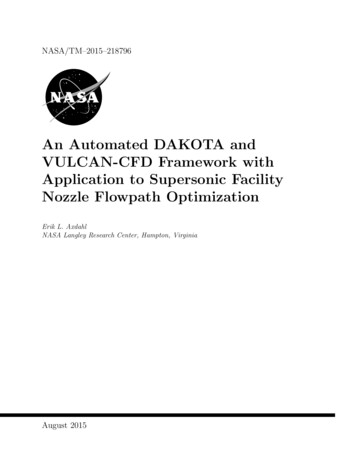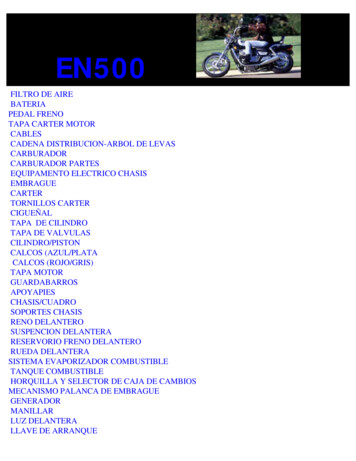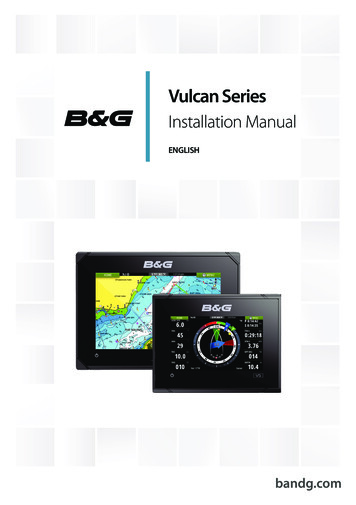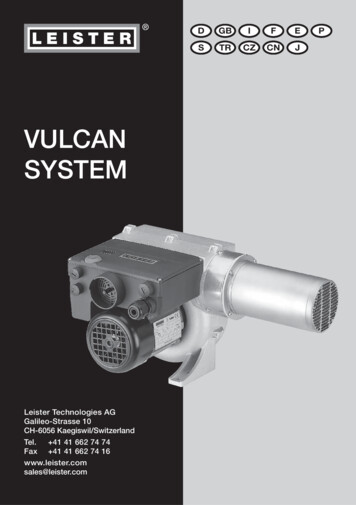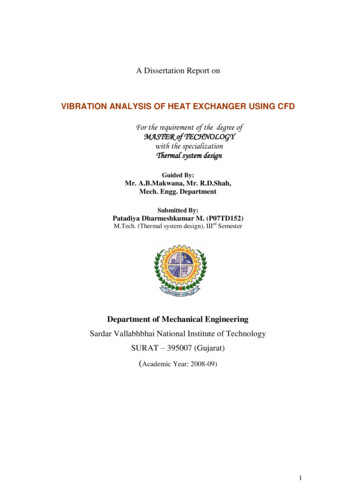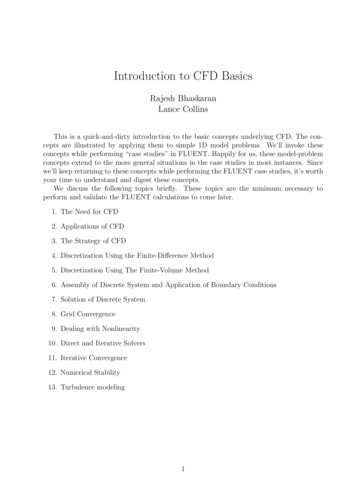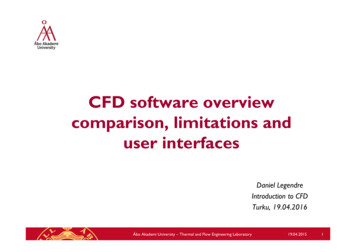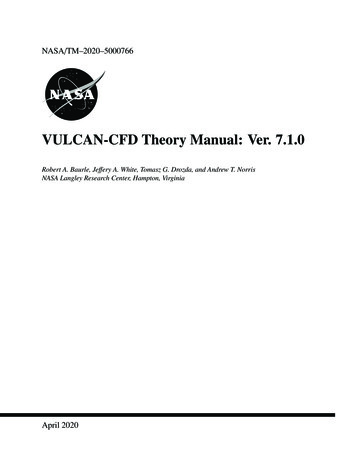
Transcription
NASA/TM–2020–5000766VULCAN-CFD Theory Manual: Ver. 7.1.0Robert A. Baurle, Jeffery A. White, Tomasz G. Drozda, and Andrew T. NorrisNASA Langley Research Center, Hampton, VirginiaApril 2020
NASA STI Program. . . in ProfileSince its founding, NASA has been dedicated tothe advancement of aeronautics and spacescience. The NASA scientific and technicalinformation (STI) program plays a key part inhelping NASA maintain this important role. CONFERENCE PUBLICATION.Collected papers from scientific and technicalconferences, symposia, seminars, or othermeetings sponsored or co-sponsored byNASA.The NASA STI Program operates under theauspices of the Agency Chief InformationOfficer. It collects, organizes, provides forarchiving, and disseminates NASA’s STI. TheNASA STI Program provides access to theNASA Aeronautics and Space Database and itspublic interface, the NASA Technical ReportServer, thus providing one of the largestcollection of aeronautical and space science STIin the world. Results are published in bothnon-NASA channels and by NASA in the NASASTI Report Series, which includes the followingreport types: SPECIAL PUBLICATION. Scientific,technical, or historical information fromNASA programs, projects, and missions, oftenconcerned with subjects having substantialpublic interest. TECHNICAL PUBLICATION. Reports ofcompleted research or a major significantphase of research that present the results ofNASA programs and include extensive data ortheoretical analysis. Includes compilations ofsignificant scientific and technical data andinformation deemed to be of continuingreference value. NASA counterpart ofpeer-reviewed formal professional papers, buthaving less stringent limitations on manuscriptlength and extent of graphic presentations. TECHNICAL MEMORANDUM.Scientific and technical findings that arepreliminary or of specialized interest, e.g.,quick release reports, working papers, andbibliographies that contain minimalannotation. Does not contain extensiveanalysis. CONTRACTOR REPORT. Scientific andtechnical findings by NASA-sponsoredcontractors and grantees. TECHNICAL TRANSLATION. Englishlanguage translations of foreign scientific andtechnical material pertinent to NASA’smission.Specialized services also include organizing andpublishing research results, distributingspecialized research announcements and feeds,providing information desk and personal searchsupport, and enabling data exchange services.For more information about the NASA STIProgram, see the following: Access the NASA STI program home page athttp://www.sti.nasa.gov E-mail your question to help@sti.nasa.gov Phone the NASA STI Information Desk at757-864-9658 Write to:NASA STI Information DeskMail Stop 148NASA Langley Research CenterHampton, VA 23681-2199
NASA/TM–2020–5000766VULCAN-CFD Theory Manual: Ver. 7.1.0Robert A. Baurle, Jeffery A. White, Tomasz G. Drozda, and Andrew T. NorrisNASA Langley Research Center, Hampton, VirginiaNational Aeronautics andSpace AdministrationLangley Research CenterHampton, Virginia 23681-2199April 2020
The use of trademarks or names of manufacturers in this report is for accurate reporting and does not constitute anoffical endorsement, either expressed or implied, of such products or manufacturers by the National Aeronautics andSpace Administration.Available from:NASA STI Program / Mail Stop 148NASA Langley Research CenterHampton, VA 23681-2199Fax: 757-864-6500
Contents1Introduction12Governing Equations2.1 Thermodynamic Nonequilibrium . . . . . . . . . . . . . . . . . . . . . . .133Reynolds-Averaged Equations64Spatially-Filtered Equations115Hybrid RAS/LES Closures146Boundary Layer Bleed Models167Performance Extraction Methods18A Thermodynamic Properties26B Transport Properties28C Finite Rate Chemistry Extensions30D Reynolds-Averaged Turbulence Closure ModelsD.1 Spalart Allmaras One-Equation Model . . . .D.2 Menter k-ω Models . . . . . . . . . . . . . .D.3 Wilcox 1998 k-ω Model . . . . . . . . . . .D.4 Wilcox 2006 k-ω Model . . . . . . . . . . .D.5 Gatski and Rumsey 2003 k-ω EAS Model . .D.6 Wall Functions . . . . . . . . . . . . . . . .D.7 Compressibility Corrections . . . . . . . . .E Spatially-Filtered Turbulence Closure ModelsE.1 Smagorinsky Model . . . . . . . . . . . . .E.2 Vreman Model . . . . . . . . . . . . . . .E.3 Yoshizawa Model . . . . . . . . . . . . . .E.4 Dynamic SGS Closures . . . . . . . . . . .3232333536384043.4444444546F Blended RAS/LES Formulation48G Improved Delayed Detached Eddy Simulation49H Bleed ModelsH.1 Doerffer/Bohning Model . . . . . . . . . . . . . . . . . . . . . . . . . . .H.2 Slater Model . . . . . . . . . . . . . . . . . . . . . . . . . . . . . . . . . .515153
IConserved Flux Method Data ReductionI.1 CMME Method Data Reduction Details . . . . . . . . . . . . . . . . . . .I.2 CMES Method Data Reduction Details . . . . . . . . . . . . . . . . . . . .565658
1IntroductionVULCAN-CFD offers a comprehensive set of capabilities to enable the simulation of continuum flowfields from subsonic to hypersonic conditions. The governing equations thatare employed include allowances for both chemical and thermal nonequilibrium processes,coupled with a wide variety of turbulence models for both Reynolds-averaged and largeeddy simulations. A description of the physical and numerical models available in thesoftware are presented in this document. However, it is emphasized that the descriptionsprovided are not intended to fully document every aspect of the models employed. Instead,the governing equations, and the models required to simulate them numerically, are presented with the goal of providing a sufficient level of detail to understand their strengthsand limitations. The reader is encouraged to access the references provided throughout thisdocument for a more complete explanation of the formulations presented.2Governing EquationsThe fundamental conservation equations employed by VULCAN-CFD to describe thermallyequilibrated chemically-reacting flows are the Navier-Stokes equations coupled with masscontinuity equations for the chemical species. These partial differential equations can bewritten as ρui t x j ρE t x j ρYm t x j ρ ρu j t x j ρui u j δ i j P τi j x j ρHu j q j τi j u i x j ρYm u j ρYm V (m)j x j 0 0 0 ẇm(1)where ρ is the density, ui is the velocity, P is the pressure, E is the total energy, H is thetotal enthalpy, τi j is the stress tensor, q j is the heat flux vector, and Ym , V (m)j , and ẇm are themass fraction, diffusion velocity, and production rate, respectively, of species “m”.The total energy is the sum of the internal and kinetic energy, i.e.,E e 1ui ui2(2)and the total enthalpy is given by the expression shown below.H E P1 h ui uiρ2(3)Here, the mixture enthalpy, h, is defined through the relationshiph nsXm 11Ym hm(4)
with the enthalpy of each species evaluated from a polynomial curve fit as described inAppendix A.VULCAN-CFD is currently limited to Newtonian fluids, where the stress tensor is related to the strain rate through the following constitutive relation,!! u j1 ui2S ij (5)τi j µ 2S i j δi j S kk ,32 x j xiand the heat flux vector (which contains contributions from heat conduction and the energyflux due to interdiffusion processes) is given by the expression provided below.nsq j λX T ρhm Ym V (m)j x jm 1(6)The diffusion velocity of species “m” is provided by Fick’s law of diffusion, i.e.,V (m) jD YmYm x j(7)and the evaluation of the mixture transport properties (µ, λ, and D) is described in Appendix B.The species production rates are governed by the law of mass action. If a generalreaction is denoted byns 1X0νmlCmm 1ns 1X00νmlCml 1, nr(8)m 1000where νml is the stoichiometric coefficient of reactant “m” in reaction “l”, νml is the stoichiometric coefficient of product “m” in reaction “l”, and Cm is the symbol for constituent “m”(the ns 1 constituent represents the third body species), then the production rate ofspecies “m”can be written in the form shown below.ẇm Wmnr Xl 1 000 ns 1Y ρn !νnlY ρn !νnl ns 1 ,νml νml k fl kbl WWnnn 1n 1000m 1, ns(9)Here, k fl and kbl are the forward and backward reaction rate coefficients of reaction “l”, ρn isthe product of density and the mass fraction of species “n”, and Wm is the molecular weightof species “m”. The molar concentration of the third body constituent, M, is defined bynsXρns 1ρm tbemWns 1Wmm 1(10)where tbem is the third body efficiency given by the kinetic model.The forward reaction rate coefficient is evaluated using the Arrhenius expression,! T alk fl Al T bl exp(11)T2
which mimics the form of the reaction rate derived from kinetic theory. The product Al T blis designed to take into account the frequency of collisions between molecules, and thesteric factor associated with the orientation of the colliding molecules. The exponentialterm is the Boltzmann factor, which represents the fraction of collisions that have an energygreater than the activation energy (defined as the product of the universal gas constant andthe activation temperature, T al ).The backward reaction rate coefficient can be written in a similar fashion, or obtainedfrom the equilibrium constant through the relationshipKcl k flkbl(12)and the equilibrium constant (in terms of molar concentrations) is given by! 0 nl GlexpK cl R u TRu T(13)0where Rhu is the universalgas constant [J/(molK)], Ru is the universal gas constant withil·atmunits of Kg·mol· K , nl is the change in moles from products to reactants, and G l is theGibbs energy of reaction defined by the following expression. Gl ns X000 νml νml (Wm gm )(14)m 1The sensible Gibbs free energy of each species is evaluated from a polynomial curve fit(see Appendix A). VULCAN-CFD can also handle more complex reaction rate representations such as pressure-dependent and arbitrary reaction order kinetics. These extensionsare described in Appendix C.To close the system, an equation of state is needed to relate the thermodynamic properties. At conditions representative of combustion applications (i.e., relatively high temperatures and low pressures), the fluid can be treated as a mixture of perfect gases. Hence, thepressure can be evaluated using the following state equationP ρRT(15)where R is the mixture gas constant given by the expression below.R Ru2.1nsXYmWmm 1(16)Thermodynamic NonequilibriumFlows that are not thermally equilibrated (i.e., the distribution of energy between translational, rotational, vibrational, and electronic modes cannot be described by a single temperature), require the introduction of additional transport equations for those energy modesthat are not equilibrated with the translational energy. The cost of solving these additionalequations, together with the limited availability of physical constants that describe the finite3
rate processes associated with the transfer of energy amongst the various modes, are important factors that must be considered when developing engineering tools for these flows.Historically, the development of the VULCAN-CFD code has been driven by the needs ofthe scramjet community, which often involves the use of complicated polyatomic molecules(e.g., heavy hydrocarbons) or even JP fuels that are basically “hydrocarbon soups” with anunspecified molecular distribution that simply satisfy certain specified combustion properties. This reality, together with the understanding that most scramjet applications arebounded below Mach 10-12 flight, led to the implementation of a simple two-temperaturethermal nonequilibrium model. 1 This formulation assumes that the translation and rotational energy modes are equilibrated at a single temperature T tr , while the vibrational andelectronic energy modes are equilibrated at temperature T ve .The transport equation for the equilibrated vibrational/electronic energy, eve , is providedby the expression below.! XnmnmX qve je ve,m eve,m u j (ρeve ) ρeve u j ρmẇm D̂m pe t {z } x j x jτm x j m 1m 1 {z } {z } {z}{z} {z }12345ninsXXνe,m3 ṅe,m Iˆm Qrad2 ρe (T tr T ve ) {z}2Wmm 19 {z m 1 } {z }76(17)8Term (1) represents the time rate of change of the vibrational/electronic energy, eve . Term(2) accounts for the convection of eve . Term (3) contains the molecular diffusion processesof the vibrational/electronic energy. Term (4) represents the energy exchange between thevibrational and translational modes due to molecular collisions. Term (5) represents the vibrational energy that is lost (or gained) due to the molecular depletion (dissociation) or production (recombination) that result from chemical kinetics. Term (6) is a term that accountsfor the combined effect of the convection of electron pressure and the work done on electrons by the electric field induced by the electron pressure gradient. Term (7) accounts forthe energy exchange due to elastic collisions between free electrons and atoms/molecules.Term (8) represents the electronic energy loss due to electron impact ionization. Finally,Term (9) accounts for the loss of electronic energy due to radiation caused by electronictransitions. Terms (6) - (8) are nonzero only when free electrons are present. These termsare currently not accounted for in VULCAN-CFD, due in part to a lack of sources for thespecies data required to evaluate these terms. As a result, the current thermal nonequilibrium formulation should not be used for problems where significant ionization is present.The radiant energy transfer rate due to electronic transitions (Qrad ) is also neglected inVULCAN-CFD.The vibrational/electronic heat flux vector, qve j , accounts for both heat conduction dueto vibrational/electronic temperature gradients and the transfer of vibrational/electronic enthal
VULCAN-CFD o ers a comprehensive set of capabilities to enable the simulation of con-tinuum flowfields from subsonic to hypersonic conditions. The governing equations that are employed include allowances for both chemical and thermal nonequilibrium processes, coupled with a wide variety of turbulence models for both Reynolds-averaged and large
